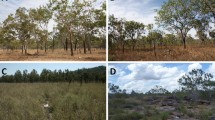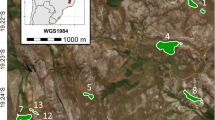Abstract
The effects of forest edge on ant species richness and community composition were examined within an urbanized area of northeast Ohio. The ground-dwelling ant fauna was inventoried in three deciduous forest fragments that have resulted from human disturbance. We surveyed ants via leaf-litter extraction along 150 m transects positioned perpendicular to the forest edge. We collected 4,670 individuals from 14 genera and 29 species. Samples closest to the forest edge contained more species and accumulated species at a higher rate than did samples located in the forest interior. Our rarefied and expected richness estimates revealed a decline of species richness from edge to forest interior. The higher ant richness at the forest edge was due mostly to the presence of species characteristic of the neighboring open habitats. Although most of the typical forest ant species were represented equally at the edge and at the forest interior, a few responded to the presence of edges with changes in their relative abundance and frequency of occurrence. Forest edges had a higher proportion of opportunistic species and a lower proportion of cryptic ants, whereas interior locations exhibited a more even distribution among ant functional groups. In addition, we documented a community composition shift between the edge and the forest interior. Consistent with previous findings, we suggest that the edge effects are most pronounced within 25 m of the forest edge, which may have implications for the overall conservation of forest-dwelling fauna.






Similar content being viewed by others
References
Adams LW (2005) Urban wildlife ecology and conservation: a brief history of the discipline. Urban Ecosyst 8:139–156
Alonso LE (2000) Ants as indicators of diversity. In: Agosti D, Majer JD, Tennant de Alonso L, Schultz T (eds) Ants: standard methods for measuring and monitoring biodiversity. Smithsonian Institution, Washington, pp 80–88
Andersen AN (1990) The use of ant communities to evaluate change in Australian terrestrial ecosystems: a review and a recipe. Proc Ecol Soc Aust 16:347–357
Andersen AN (1997a) Using ants as bioindicators: multiscale issues in ant community ecology. Conserv Ecol 1:1–8
Andersen AN (1997b) Functional groups and patterns of organization in North American ant communities: a comparison with Australia. J Biogeogr 24:433–460
Andersen AN, Majer JD (2004) Ants show the way down under: invertebrates as bioindicators in land management. Front Ecol Environ 2:291–298
Baker J, French K, Whelan RJ (2002) The edge effect and ecotonal species: bird communities across a natural edge in southeastern Australia. Ecology 83:3048–3059
Bolger DT, Suarez AV, Crooks KR, Morrison SA, Case TJ (2000) Arthropods in urban habitat fragments in southern California: area, age, and edge effects. Ecol Appl 10:1230–1248
Bolton B, Alpert G, Ward PS, Naskrecki P (2007) Bolton’s catalogue of ants of the world: 1758–2005. Harvard University Press, Cambridge, CD-ROM
Brown WL (2000) Diversity of ants. In: Agosti D, Majer JD, Tennant de Alonso L, Schultz T (eds) Ants: standard methods for measuring and monitoring biodiversity. Smithsonian Institution, Washington, pp 45–79
Burnham KP, Overton WS (1978) Estimation of the size of a closed population when capture probabilities vary among animals. Biometrika 65:623–633
Burnham KP, Overton WS (1979) Robust estimation of population size when capture probabilities vary among animals. Ecology 60:927–936
Carvalho KS, Vasconcelos HL (1999) Forest fragmentation in central Amazonia and its effects on litter-dwelling ants. Biol Conserv 91:151–157
Chao A (1987) Estimating the population size for capture–recapture data with unequal catchability. Biometrics 43:783–791
Clarke KR (1993) Non-parametric multivariate analysis of changes in community structure. Aust J Ecol 18:117–143
Colwell RK (2009) EstimateS: statistical estimation of species richness and shared species from samples. Version 8.2. User’s guide and application published at: http://purl.oclc.org/estimates. Accessed 6 March 2010
Colwell RK, Coddington JA (1994) Estimating terrestrial biodiversity through extrapolation. Philos Trans R Soc Lond B 345:101–118
Colwell RK, Mao CX, Chang J (2004) Interpolating, extrapolating and comparing incidence-based species accumulation curves. Ecology 85:2717–2727
Coovert GA (2005) The ants of Ohio. Bull Ohio Biol Surv New Ser 15:1–196
Dauber J, Wolters V (2004) Edge effects on ant community structure and species richness in an agricultural landscape. Biodivers Conserv 13:901–915
Didham R (1997) The influence of edge effects and forest fragmentation on leaf litter invertebrates in Central Amazonia. In: Laurance WF, Bierregaard RO (eds) Tropical forest remnants: ecology, management and conservation of fragmented communities. University of Chicago Press, Chicago, pp 55–70
Didham RK, Ghazoul J, Stork NE, Davis AJ (1996) Insects in fragmented forests: a functional approach. Trends Ecol Evol 11:255–260
Didham RK, Hammond PM, Lawton JH, Eggleton P, Stork NE (1998) Beetle species responses to tropical forest fragmentation. Ecol Monogr 68:295–323
Durães R, Martins WP, Vaz-de-Mello FZ (2005) Dung beetle (Coleoptera: Scarabaeidae) assemblages across a natural forest-cerrado ecotone in Minas Gerais, Brazil. Neotrop Entomol 34:721–731
Ewers RM, Thorpe S, Didham RK (2007) Synergistic interactions between edge and area effects in a heavily fragmented landscape. Ecology 88:96–106
Fenske-Crawford TJ, Niemi GJ (1997) Predation of artificial ground nests at two types of edges in a forest-dominated landscape. Condor 99:14–24
Fisher BL (1998) Ant diversity patterns along an elevational gradient in the Réserve Spéciale d’Anjanaharibe-Sud and on the western Masoala Peninsula, Madagascar. Fieldiana Zool 90:39–67
Fisher BL (1999) Improving inventory efficiency: a case study of leaf-litter ant diversity in Madagascar. Ecol Appl 9:714–731
Folgarait PJ (1998) Ant biodiversity and its relationship to ecosystem functioning: a review. Biodivers Conserv 7:1221–1244
Fowler HG, Silva CA, Ventincinque E (1993) Size, taxonomic and biomass distributions of flying insects in central Amazonia: forest edge vs. understory. Rev Biol Trop 41:755–760
Francoeur A (2007) The Myrmica punctiventris and M. crassirugis species groups in the Nearctic region. Mem Am Ent Inst 80:153–185
Gauch HG, Whittaker RH (1981) Hierarchical classification of community data. J Ecol 69:537–557
Gibb H, Hochuli DE (2002) Habitat fragmentation in an urban environment: large and small fragments support different arthropod assemblages. Biol Conserv 106:91–100
Gleason HA, Cronquist A (1991) Manual of vascular plants of northeastern United States and adjacent Canada. New York Botanical Garden, Bronx
Gotelli N, Colwell RK (2001) Quantifying biodiversity: procedures and pitfalls in the measurement and comparison of species richness. Ecol Lett 4:379–391
Halme E, Niemelä J (1993) Carabid beetles in fragments of coniferous forest. Ann Zool Fenn 30:17–30
Hammer O, Harper DAT, Ryan PD (2001) PAST: Paleontological statistics software package for education and data analysis. Paleontol Electron 4:9 pp
Hoffmann BD, Andersen AN (2003) Responses of ants to disturbance in Australia, with particular reference to functional groups. Austral Ecol 28:444–464
Hölldobler B, Wilson EO (1990) The ants. Harvard University Press, Cambridge
Holway DA (2005) Edge effects of an invasive species across a natural ecological boundary. Biol Conserv 121:561–567
Hortal J, Borges PAV, Gaspar C (2006) Evaluating the performance of species richness estimators: sensitivity to sample grain size. J Anim Ecol 75:274–287
Ingham DS, Samways MJ (1996) Application of fragmentation and variegation models to epigaeic invertebrates in South Africa. Conserv Biol 10:1353–1358
Ivanov K, Milligan J, Keiper J (2010) Efficiency of the Winkler method for extracting ants (Hymenoptera: Formicidae) from temperate-forest litter. Myrmecol News 13:73–79
Kaspari M, Majer JD (2000) Using ants to monitor environmental change. In: Agosti D, Majer JD, Tennant de Alonso L, Schultz T (eds) Ants: standard methods for measuring and monitoring biodiversity. Smithsonian Institution, Washington, pp 89–98
King JR, Porter SD (2005) Evaluation of sampling methods and species richness estimators for ants in upland ecosystems in Florida. Environ Entomol 34:1566–1578
Kotze DJ, Samways MJ (1999) Invertebrate conservation at the interface between the grassland matrix and natural Afromontane forest fragments. Biodivers Conserv 8:1339–1363
Kotze DJ, Samways MJ (2001) No general edge effects for invertebrates at Afromontane forest/grassland ecotone. Biodivers Conserv 10:443–466
Laurance WF, Lovejoy TE, Vasconcelos HL, Bruna EM, Didham RK, Stouffer PC, Gascon C, Bierregaard RO, Laurance SG, Sampaio E (2002) Ecosystem decay of Amazonian forest fragments: a 22-year investigation. Conserv Biol 16:605–618
Lessard J, Buddle CM (2005) The effects of urbanization on ant assemblages (Hymenoptera: Formicidae) associated with the Molson Nature Reserve, Quebec. Can Entomol 137:215–225
Lidicker WZ (1999) Responses of mammals to habitat edges: an overview. Landsc Ecol 14:333–343
Majer JD (1983) Ants: bio-indicators of minesite rehabilitation, land-use, and land conservation. Eng Manag 7:375–385
Majer JD, Delabie JHC, McKenzie NL (1997) Ant litter fauna of forest, forest edges and adjacent grassland in the Atlantic rain forest region of Bahia, Brazil. Insectes Sociaux 44:255–266
McFrederick QS, LeBuhn G (2006) Are urban parks refuges for bumble bees Bombus spp. (Hymenoptera: Apidae)? Biol Conserv 129:372–382
Murcia C (1995) Edge effects in fragmented forests: implications for conservation. Trends Ecol Evol 10:58–62
Musgrave DK, Holloran DM (1980) Soil survey of Cuyahoga County, Ohio. Ohio Department of Natural Resources, Division of Lands and Soil, Columbus
Ness JH, Morin DF (2008) Forest edges and landscape history shape interactions between plants, seed-dispersing ants and seed predators. Biol Conserv 141:838–847
Niemelä J (1999) Ecology and urban planning. Biodivers Conserv 8:119–131
NOAA (2010) National Oceanic and Atmospheric Administration. National Weather Service Forecast Office, Cleveland. http://www.erh.noaa.gov/cle/climate/cle/-climatecle.html. Retrieved 9 February 2010
Ries L, Fletcher RJ, Battin J, Sisk TD (2004) Ecological responses to habitat edges: mechanisms, models and variability explained. Annu Rev Ecol Syst 35:491–522
Schlick-Steiner BC, Steiner FM, Moder K, Seifert B, Sanetra M, Dyreson E, Stauffer C, Christian E (2006) A multidisciplinary approach reveals cryptic diversity in Western Palearctic Tetramorium ants (Hymenoptera: Formicidae). Mol Phylogenet Evol 40:259–273
Smith MR (1957) Revision of the genus Stenamma Westwood in America north of Mexico (Hymenoptera: Formicidae). Am Midl Nat 57:133–174
Sobrinho TG, Schoereder JH (2007) Edge and shape effects on ant (Hymenoptera: Formicidae) species richness and composition in forest fragments. Biodivers Conserv 16:1459–1470
Strayer DL, Power ME, Fagan WF, Pickett STA, Belnap J (2003) A classification of ecological boundaries. Bioscience 53:723–729
Suarez AV, Bolger DT, Casse TJ (1998) Effects of fragmentation and invasion on native ant communities in coastal southern California. Ecology 79:2041–2056
Thompson B, McLachlan S (2007) The effects of urbanization on ant communities and myrmecochory in Manitoba, Canada. Urban Ecosyst 10:43–52
Underwood EC, Fisher BL (2006) The role of ants in conservation monitoring: if, when, and how. Biol Conserv 132:166–182
Vasconcelos HL (1999) Effects of forest disturbance on the structure of ground-foraging ant communities in central Amazonia. Biodivers Conserv 8:409–420
Walter BA, Moore JL (2005) The concepts of bias, precision and accuracy, and their use in testing the performance of species richness estimators, with a literature review of estimator performance. Ecography 28:815–829
Yahner RH, Scott DP (1988) Effects of forest fragmentation on depredation of artificial nests. J Wildl Manag 52:158–161
Acknowledgments
We thank J. Milligan for assisting with sample collection, processing and sorting; J. Trager, O. Lockhart, R. Gibson, and two anonymous reviewers for their comments and suggestions on earlier versions of the manuscript; and the Cleveland Metroparks for permission to collect ants from their protected areas and preserves.
Author information
Authors and Affiliations
Corresponding author
Rights and permissions
About this article
Cite this article
Ivanov, K., Keiper, J. Ant (Hymenoptera: Formicidae) diversity and community composition along sharp urban forest edges. Biodivers Conserv 19, 3917–3933 (2010). https://doi.org/10.1007/s10531-010-9937-3
Received:
Accepted:
Published:
Issue Date:
DOI: https://doi.org/10.1007/s10531-010-9937-3




